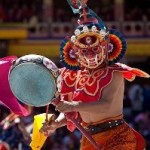7 Reasons To Visit Bhutan
 Buddhism
Buddhism
Buddhism is ingrained into Bhutan's landscape and daily life, with prayer flags, prayer wheels and white chortens. A basic understanding of Buddhism really does add to the experience of travelling through Bhutan, and helps one to really appreciate the complex visual tapestries that are found throughout the country.Mahayana Buddhism is the state religion of Bhutan, and Buddhists comprise two-thirds to three-quarters of its population.
 Dzongs
Dzongs
Bhutan's dzongs are the most striking architectural feature of the country; large white washed forts with battered walls (inward sloping to appear larger than they actually are). They are the administrative and religious centres of authority in each region. Two of Bhutan's best known dzongs can be found at Punakha and Trongsa. Most distinct and magnificent, the Dzong (fortress) is an architectural masterpiece with as much interest in its origin as to its functions and beauty. Thrilling myths and legends circle the Dzongs
 Festivals
Festivals
Festivals or 'tsechus' are a major part of Bhutanese life and offer a unique cultural insight into this Himalayan Kingdom. They are colourful affairs with lots of masked dancing and bright costumes offering wonderful photo opportunities. During the larger festivals Bhutan is very popular with tourists and some of its charm can be lost, so visiting the smaller festivals is advisable. It is said that everyone must attend a Tshechu and witness the mask dances at least once to receive the blessings and wash away the sins.
 Gross National Happiness
Gross National Happiness
Gross National Happiness is a truly unique and very Bhutanese idea. It is a more holistic approach to development and is drawn from the Buddhist belief that the ultimate purpose of life is inner happiness. It has been used to measure Bhutan's development since 1972 when the fourth king proposed the idea. The assessment of gross national happiness was designed in an attempt to define an indicator that measures quality of life or social progress in more holistic and psychological terms than only the economic indicator of gross domestic product (GDP)
 Off the beaten track
Off the beaten track
Bhutan only has a fraction of visitors compared to most countries, with only a limited number of flights in and out of one airport. Visiting Bhutan you are able to experience a way of life that in the rural areas has largely remained unchanged for centuries. You may wish to visit a local farm or even stay in a simple traditional Bhutanese home. Bhutan has long maintained a policy of strict isolationism, both culturally and economically








